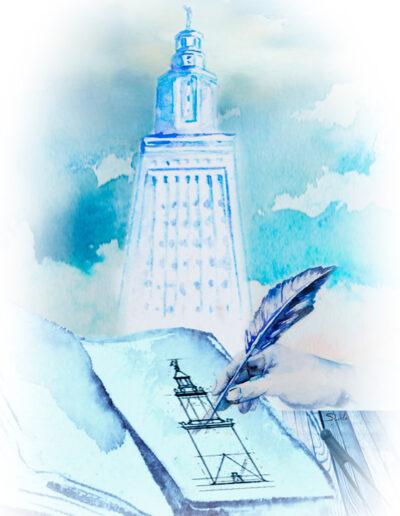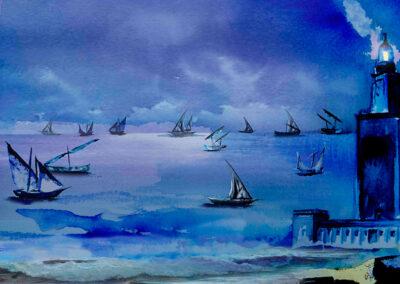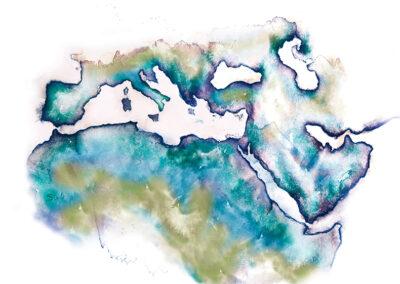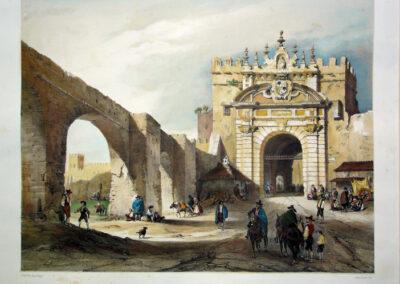
Ibn al Shaykh of Malaga dazzled by the
Lighthouse of Alexandria
PART I
By María Jesús Viguera Molins.
Arabist. Member of the Royal Academy of History.
The Lighthouse of Alexandría, the Seventh Wonder of the Ancient World, was widely described by Arab authors. Among them, Ibn al-Shaykh of Malaga produced one of the most accurate descriptions of all.
Yet Alexandria still kept magnificent constructions from antiquity, which medieval people sometimes attributed to communities of giants. They were great monuments not only admired by the natives from Alexandria of their time, but, as it happened in many other places, they were inhabited and used, destroyed sometimes to be reused −like that huge statue located in Alexandria, which in the 8th century the Egyptian Walid resolved to mint copper coins.
Ibn al-Shaykh reaches Alexandria in 1165 after an extraordinary geographical voyage through the Mediterranean; but then, inevitably, our traveler also made an in-depth journey through history and time, and he immerses himself in the old constructions, carried away by the rapture of time.
íLet us evoke to what an extent the material vestiges of old represented to medieval people their main contact with the past. Common people, or people with average levels of culture, were not always, then, able to access the written sources dealing with past times, as these had not reached a scope beyond an elite of wise men, nor the precise chronology and archaeological knowledge to locate or explain those archaic remains exist. And this led to strangeness of bygone times. This is why it seems to me that, given the detailed description of the Alexandria Lighthouse, our Ibn al-Shaykh of Malaga also went back in time by trying to unravel that monument, delving into a complex and wide research, in the same way that he traveled to that city from his Andalusi harbour to the Egyptian one, watching it carefully.
Who was Ibn al-Shaykh?
Spanish Arabist Asín Palacios dealt with ibn al-Shaykh’s work. The writer A. Haddadi has presented our author and his Book of A and B (Kitab alif ba) in the Actas del IV Encuentro de Estudios Andalusíes y Magrebíes (Proceedings of the Conference of the IV Encounter of Andalusí and Maghreb Studies). Only a few Andalusí sources devoted to the traveller from Málaga, but scant strokes of his life; he was named Abu al-Hayyay Yusuf Ibn al-Shaykh al Balawi. He was born and died in Málaga in 1132 and 1208, respectively.
The Spanish scholar and Arabist Asín Palacios (1871-1944) has brilliantly recorded, in another essential article about the “Book of A and B by Yusuf Benaxeikh from Malaga”[1] that Ibn al-Shaykh was an average-level man of culture and letters; meaning that he did not produce great works either in prose or in verse, although he composed a remarkable book of adab (book of good letters) in the style of an educational encyclopaedia of good manners to contribute to the training of one of his sons, Abd al-Rahim. And he originally entitled the work as Book of A and B (Kitab alif ba), or Alphabet, for he gathered there, in a sort of hodgepodge, a mix of classified news, each entry listed alphabetically by its subject.
His travel to the East, in 1165, returning to Malaga in 1166, should have been a major milestone in his life. It would still be about forty years before he would begin writing his Alphabet, where he included the direct notes that he had written about the Lighthouse of Alexandria, along with many other indications.
The inner profile of Ibn al-Shaykh described by Asín Palacios is interesting because he underlines that Ibn al-Shaykh was not a geographer, the fact that places us before the perspectives of his very comprehensive and novel description of the Lighthouse, as he possessed architectural knowledge, with “the skills that would allow the success in the humble task of gazing carefully reality and reflect it clearly and accurately in writing. This is supported by the fact reported by his biographer Ibn al-Abbar (end of 11th c.) in his work Takmila that Ibn al-Shaykh had personally erected twenty-five mosques and sank fifty wells in his native Malaga, even paying them with his own resources. This explains much about the strong interest Ibn al-Shaykh showed in the Lighthouse of Alexandria and its architectural intricacies. And to this interest one two more can be added: one in a general sense, as it was the medieval interest in the remaining patrimony left by ancient people; the other one, more focused, was that of comparisons, which in my opinion, our author wished to establish with the Lighthouse of Cadiz. Both questions will be analysed next.
Arab authors and the legacy of old monuments
Constructions of old were, also in the Middle Ages, a tangible legacy which were reused many times with dignity, with appreciation. Andalusí texts bring to us the admiration for the old monuments, mainly those of the Rum, the Romans. Let’s recall just one example, what chronicler from Cordoba al-Razi quotes enthusiastically “one of the manifestations of their power [of their builders, in Merida] is shown in the way they carry water inside a construction”, that is to say, the aqueducts from Merida: and let’s pay attention to this reference mentioning the prestige of those who erected it”. Arabic texts in al-Andalus also describe how the old statues became symbolic guardians in the gates and cities or coasts, as a warning to those who approach and to guide navigators, like the Lighthouse of Cadiz, whose memory I think is essential, precisely related to the description of the Lighthouse of Alexandria by our traveler Ibn al-Shaykh, as we will see further on. There were also wonderful and old remains all around Cadiz itself that have not been altered by the passing of time, witnesses of its power and the existence of a kingdom”, according to an Anonymous description of al-Andalus, the Dikr, to mention only one reference.
Now a medieval Arabic text reflects again to us two symptoms: The clear lasting existence of old vestiges and the admiration they stir up.
Old Roman works were discovered and reconstructed in other cases by Andalusi people, like the Seville’s water pipes, which remain standing today, the so-called Caños de Carmona. Sahib al-Salat, a chronicler from the Almohad period, mentions how his caliph al-Mansur, in 1171 and 1172, aimed at the improvement of the city of Seville, and among other constructions:
“He took care to take water [to the Almohad palaces] to irrigate what had been planted. Outside Puerta de Carmona (Carmona’s Gate), in the plain, there was a road that led to the city of Carmona with the traces of ancient irrigation canals that had been recovered. The ground rose above it, and on the soil, there was a line of stones whose meaning was unknown. It was engineer Ja’is who went there and dug around the mentioned vestiges, and here it was the layout of an aqueduct which formerly channelled water to Seville. It was probably a work by the first kings of the Romans, from past times, by people from the past who had disappeared in former centuries.”
The utility of what was done in past times, and that is rebuilt, is again highlighted in Arabic texts. There was much admiration for the old monuments, as there was destruction too. And above all was a very popular one: the Lighthouse of Cadiz, as we will see below, in the second part of this text.
Ibn al-Shaykh discerns his own constructive interests regarding the Alexandria Lighthouse −which started appearing in the texts of Andalusi writers in that profound 12th century− which provides it with originality and verisimilitude.
[1] Calero Secall, M. I. y Martínez Enamorado, V., Málaga, Ciudad de al-Andalus. Málaga, 1995.
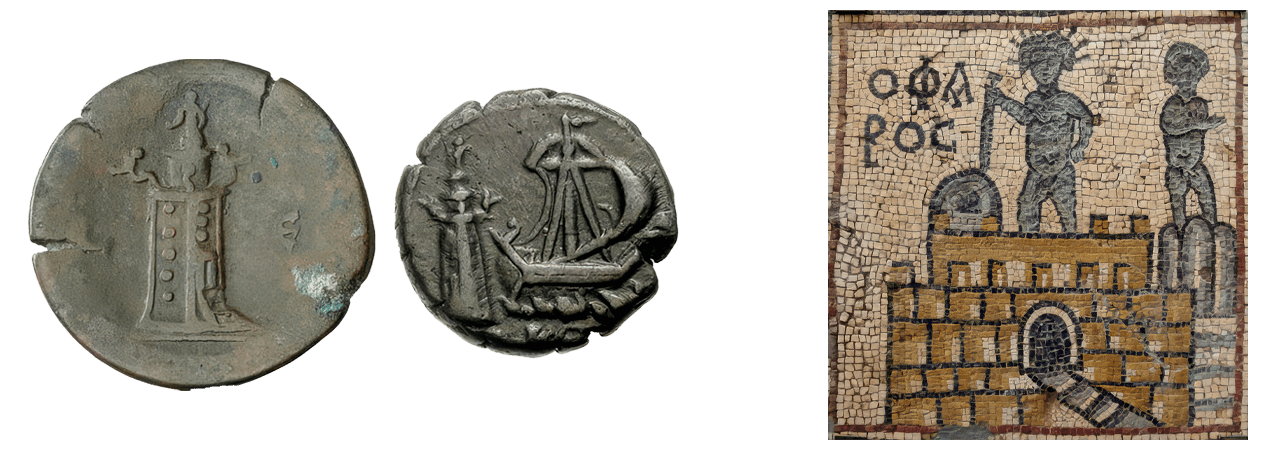
|
BIBLIOGRAPHY
|


